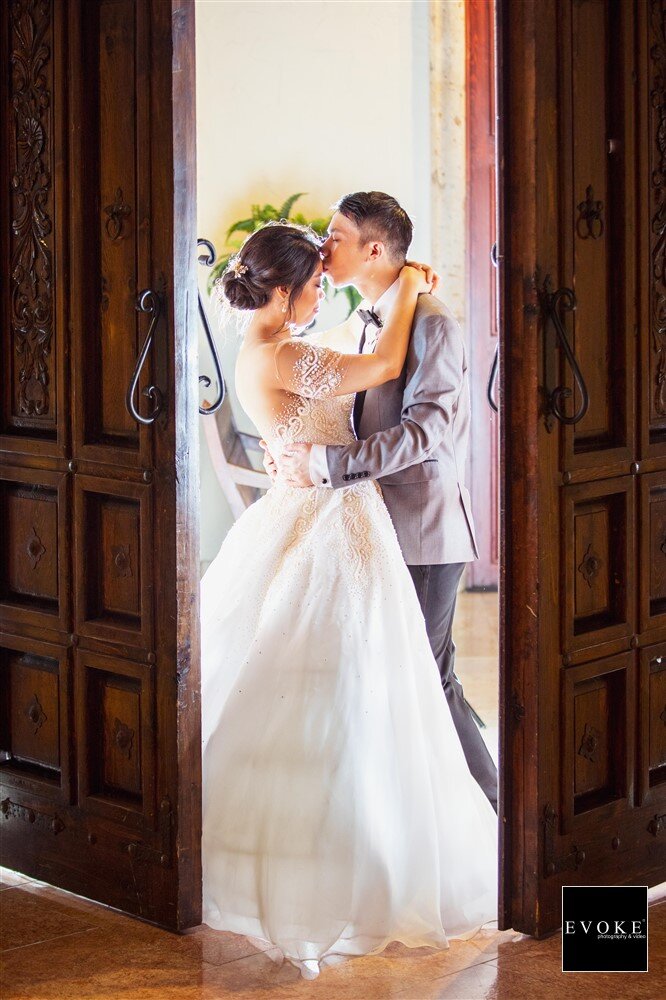At The Bell Tower on 34th in Houston, Texas. Photo by: Evoke Photography and Video
The year 2020 will forever be associated with, among other things, certain terms and figures of speech. As the COVID-19 pandemic began changing nearly every aspect of daily life,
references to “working remotely” and “Zoom meetings” became commonplace. So did “social distancing,” “flattening the curve” (the ability to manage the number of COVID-19 cases without overwhelming hospitals), and “panic shopping.”
The wedding industry gained its share of newly popular terms, too, mostly resulting from the creative approaches people took to getting married as safely as possible during a pandemic. One of those words is “minimony,” a small wedding ceremony held with the intention of following up with a larger celebration later.
Another term we started hearing quite a bit in 2020 was “micro wedding,” which describes an intimate wedding with no more than 50 guests (some definitions use even smaller numbers). Unlike a minimony, a micro wedding is the main event, not a precursor to a more elaborate ceremony or reception to come.
“While couples have certainly gotten married in intimate ceremonies before, the idea of this micro wedding trend was truly defined by couples determined to get married during the pandemic!” Anna Price Olson, associate editorial director of Brides magazine, recently told Newsweek.
Many in the wedding industry believe the micro wedding is a term, and an option, that’s here to stay.
“Micro weddings aren’t only romantic and intimate. They have multi-fold benefits, such as savings on cost and smaller amounts of planning,” a Taylor and Hart blog explained. “As people discover the charm and character of a more stripped-back wedding, it’s a format for celebration that will only be perfected over time.”
With that in mind, we’ve put together some guidelines to help you achieve micro wedding success.
First, let’s take a closer look at what micro weddings have to offer.
Small Events, Big Benefits
Micro weddings became a trend to meet a practical need: They’ve made holding weddings in the COVID-19 era more doable. In some cases, they’ve given couples the flexibility to hold their events in less-than-traditional locations (from restaurants to private homes) after venues were forced to close. The small number of guests at micro weddings also has made it easier to keep couples and guests at a safe distance from one another, reducing the risk of spreading illness.
But micro weddings have other benefits, too. For one thing, during an era of limited contact with others, these small-scale events allow participants to spend time with loved ones and share a meaningful experience.
“I think some couples appreciate a more intimate wedding where they can really focus on their special day and invite the people they love the most,” Annie Dunne of A.D. Event Design said during an interview with Image. “Whilst big weddings can be lovely, the couple may not see much of those they actually want to spend the day with.”
Micro weddings tend to give couples a sense of freedom, as well, to simplify their events, Dunne said.
“With fewer people, the couple can focus on elements that are important to them, whether that’s a tasting menu, decoration or entertainment. Ordinarily, there are so many ‘rules’ and traditions when it comes to weddings, and in a funny way, I feel COVID has allowed couples to be free, focusing instead on the experience.”
Micro weddings also have cost-cutting potential: With a smaller guest list, you need less food and beverages, which often represent a major portion of wedding expenditures. (That said, depending on your food, vendor, and location choices, a micro wedding, like any other event, can get quite expensive.)
A Few Suggestions
If the benefits of micro weddings appeal to you, then we have a few suggestions that can help you capitalize on them.
Continue to encourage social distancing. Now that many wedding venues are open again, consider selecting a location with a capacity that exceeds your guest count. (A capacity that’s two to three times the number of people is ideal.) This helps protect everyone who attends and works at your event.
"Booking a larger space to host a smaller crowd comes with plenty of perks, said Kayla English of Airside Event Spaces in British Columbia. “Setting up a ceremony and reception area in the same space eliminates the need for a room flip or additional rental space. More elbow room allows for more creativity and fun decor options. We have successfully hosted beautiful micro weddings in our renovated aircraft hangar."
Invite those closest to you. This part can be tricky; you don’t want people in your lives to feel left out. But one of the defining qualities of a micro wedding is a small guest list.
“Look through your text messages and calls, and only invite those you’ve spoken to within the last three months,” Jove Meyer of Jove Meyer Events suggested in an interview with Brides magazine. “We speak to those who matter most — it’s that simple.”
Play With Your Food. A micro wedding is a perfect opportunity to incorporate fun or creative touches into your wedding menu, from comfort food stations to a special entrée.
“A micro wedding also enables you to go for something totally untraditional,” said Amy Nichols, founder of Intimate I Dos by Amy Nichols Events. “Consider serving a type of cuisine that's harder to do for a large scale guest count.”
Include personal touches. Incorporate elements with special meaning into your day. That might mean creating your own vows, writing out invitations, or picking sentimental “something old, something new, something borrowed, something blue” items to keep with you.
Capture the day. No matter how small your wedding is, it still will be a hugely important day. You’ll want to hire a photographer and/or a videographer. Talk with your vendor about creating a special package of shots that meets your needs.
In a way, a micro wedding is less about size and more about customization. It’s your chance to celebrate your new life together with the people you love most, doing what you most enjoy.

